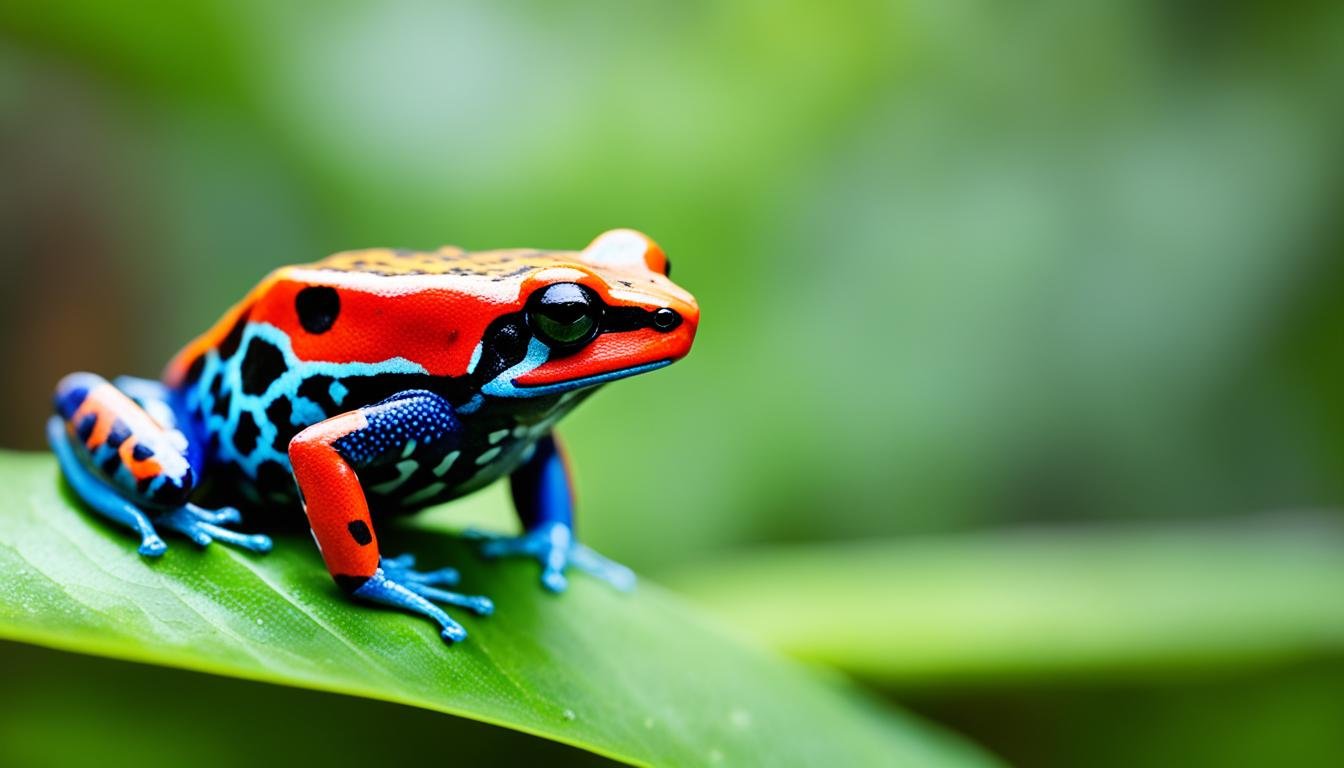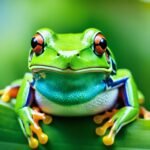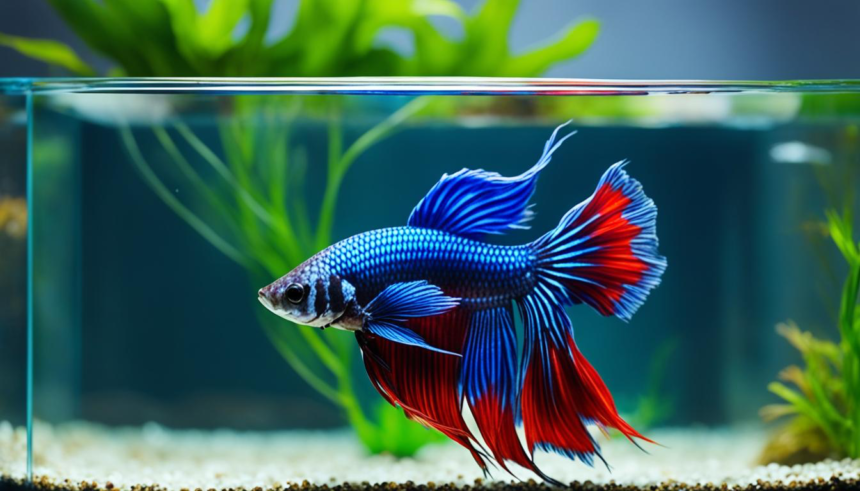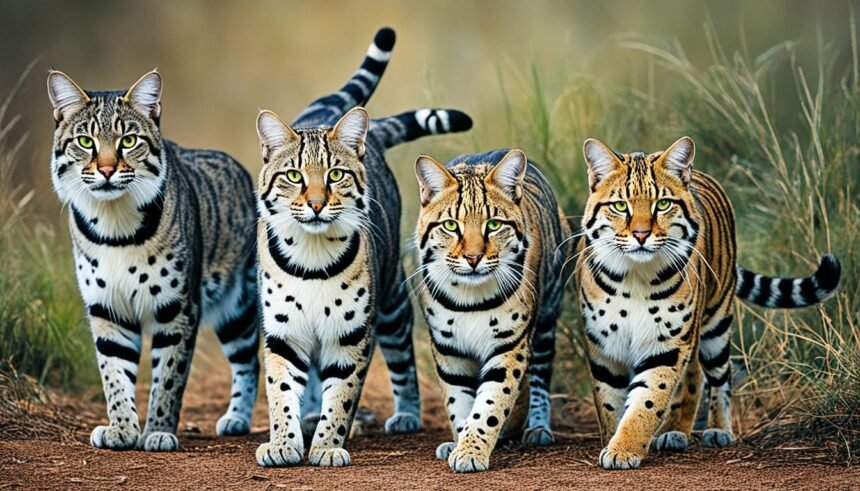Poison dart frogs are stunning, with bright colors against their tropical homes. But these amphibians are in danger. Recent studies show many amphibian species, including poison dart frogs, are at risk. The International Union for Conservation of Nature (IUCN) says before their study, we didn’t know the risk for many amphibians. Now, with new research, over 1,000 species are considered ‘Threatened,’ including some ‘Endangered’ or ‘Critically Endangered.’
The focus on conservation status is growing as many of these frogs live in South America and Southeast Asia. These areas have the most threatened amphibian species. Poison dart frogs’ survival is made harder by forest loss, human growth, and destroying habitats. These frogs show us the global crisis of losing biodiversity.
Poison dart frogs are known for their deadly skin toxins. They face many dangers like illegal wildlife trade, which is worth $10 to $20 billion a year, and losing their homes. This makes saving them more important than ever. Conservation efforts are crucial for these unique species and the biodiversity they bring.
Scientists and conservationists are working hard to help them. The future of poison dart frogs is still unsure. They remind us how delicate and connected life on Earth is.
The Allure and Danger of Poison Dart Frogs
Poison dart frogs are known for their vibrant colors and distinct patterns. These colors hide a dangerous secret. Despite their small size, they have a deadly allure for both nature lovers and scientists. Their skin makes a potent poison, batrachotoxin. This poison can cause heart failure and death.
In western Colombia’s dense Chocó forest, there’s a 124-acre reserve for the endangered golden poison dart frog. This haven gets help from groups like the World Land Trust, American Bird Conservancy, and Global Wildlife Conservation. It’s part of a bigger project named the Chocó Corridor, aiming to save vital habitats.
| Statistic | Description |
|---|---|
| Conservation Status | The golden poison dart frog is marked as endangered on The Red List of threatened species. |
| Location | The reserve is located in the biodiverse Chocó forest, western Colombia. |
| Toxin Duration | Poison dart frogs can retain their deadly nature for over two years. |
| Captive Toxicity | When raised in captivity and fed a diet of crickets and fruit flies, these frogs lose their toxic potency. |
| Threats | Despite their danger, collectors love poison dart frogs for their exotic beauty. This leads to risks in trading these toxic animals. |
The Chocó Emberá Indians have used batrachotoxin for hunting darts. This shows the power of the toxin. But, the golden poison frog is at risk. Its toxic beauty makes it popular among exotic pet collectors. This threatens their survival.
Places like Round Island in Mauritius and Floreana in the Galápagos highlight the need to protect species like the golden poison dart frog. They tell us about the fine line between beauty and danger. These frogs are part of a bigger story about Earth’s losing biodiversity. It’s crucial we act now to save them and other endangered species.
Understanding the Habitat of Poison Dart Frogs
Poison dart frogs are known for their bright colors. They play a key role in the ecosystem of tropical rainforests. Climate change and deforestation threaten their existence. This raises questions about their ability to adapt to a rapidly changing world.
The Significance of Tropical Rainforests for Dart Frogs
Poison dart frogs live in the heart of tropical rainforests. This environment provides everything they need to survive. They find food, mates, and shelter in these forests.
Their diet allows them to develop potent toxins. Frogs in undisturbed forests have a wider variety of skin toxins. Those in damaged forests have less. This shows how important their habitat is for their defense mechanisms.
Impact of Deforestation on Poison Dart Frog Populations
Deforestation breaks up the vast stretches of rainforests. This affects poison dart frog populations badly. The 12% increase in deforestation in 2020 shows a troubling trend. It reduces the food and shelter frogs need to survive.
Areas without forests have fewer toxic ants for frogs to eat. This means frogs in these areas have weaker toxins. The health of poison dart frogs is closely tied to their environment.
Effects of Climate Change on Poison Dart Frogs
Climate change poses a big risk to poison dart frogs. It changes their habitats. This affects their survival.
While they can fight off some threats, they struggle with habitat loss and climate changes. This may mess up their mating and foraging. It even affects how they find their way around. Protecting these frogs from climate change is crucial.
Human Impact on Poison Dart Frog Populations

The world of poison dart frogs is in danger due to human actions. Their small size does not make them less important in facing big threats. Pollution, destroying their homes, and being caught for pets are big reasons they are disappearing.
The Role of Pollution in Threatening Dart Frogs
Poison dart frogs are fighting to survive because of pollution. Harmful chemicals and waste end up where they live, hurting their water and land. This pollution harms their health, how they have babies, and what they eat.
Habitat Destruction and Its Consequences
Their homes are being destroyed, which is a huge problem. Cutting down forests for farms or mines takes away places where they live and find food. As their home gets smaller, their numbers do too.
Illegal Pet Trade: A Significant Threat to Poison Dart Frogs
People are catching these frogs to sell as pets. This is bad for the frogs in the wild and can spread sickness. Collectors want them badly, which makes things even worse for these tiny creatures.
Talking about the problem with facts is essential. For example, almost 800 frogs were caught illegally in 1998. The illegal pet business makes between $10 and $20 billion a year.
| Aspect | Impact on Poison Dart Frogs | Conservation Efforts |
|---|---|---|
| Illegal Pet Trade | Major reduction in native populations due to smuggling | Captive breeding programs and increased surveillance at trade hubs |
| Habitat Destruction | Loss of natural habitat leading to population declines | Establishment of protected reserves and reforestation projects |
| Pollution | Contaminated habitats impairing frog health and vitality | Regulation and reduction of harmful chemicals in frog habitats |
Efforts to save these frogs are working. Tesoros de Colombia has helped by breeding frogs instead of taking them from the wild. Even though it was hard and costly for Ivan Lozano, it has started to work, making wild frogs less needed.
This change is beginning to show results. Conservationists are working with people who have these frogs as pets. This helps everyone understand and follow the laws to protect these frogs. Thanks to this teamwork, places like the Rana Terribilis Amphibian Reserve are helping save them. Ranger programs also help protect these frogs and their homes, helping conservation efforts all over the world.
Are Poison Dart Frogs Endangered?
The beautiful poison dart frogs are in danger. They are listed as endangered on the IUCN Red List. Their survival is threatened by habitat loss, pollution, and the exotic pet trade. The deadly chytrid fungus, Batrachochytrium dendrobatidis (Bd), is also a big threat. We’ll discuss the issues these frogs face and the efforts to save them.
In 2019, fires destroyed about 30,000 hectares of rainforest. This loss affects not only the poison dart frogs but also many other species. The smuggling of these frogs has grown over the last 15 years. Brightly colored frogs are especially at risk due to their strong toxins.
The golden poison frog is especially powerful, able to kill many mice or even big animals like elephants. However, one snake species has evolved to resist this toxin. But still, the illegal wildlife trade puts these unique frogs at great risk. It threatens the diverse genetics within their wild populations.
Human actions are the biggest threat to these frogs, even more than natural predators. The seizure of 800 frogs at El Dorado International Airport shows the illegal trade’s massive scale. It makes billions annually. This trade pushes species like the green and black poison frog, Cainarachi poison frog, emerald poison frog, and pleasing poison frog towards extinction.
- Conservation Centers: Tesoros de Colombia is a beacon of hope. It can breed up to 1,500 frogs a year, focusing on those most endangered. This center’s work is lowering market prices for golden poison frogs. It also encourages collectors in the US to buy frogs from ethical sources.
- Education and Ethical Practices: Ivan Lozano’s debt led to vital conservation efforts. By breeding and selling golden poison frogs at fair prices, he offers a legal alternative to wild-caught frogs. He also teaches hobbyists about conservation. This move towards ethical practices is key for the frogs’ survival.
Poison dart frogs symbolize the larger problems facing our world’s biodiversity. Although their situation is dire, there is hope. By working together, we can protect these frogs and change their fate, one step at a time.
Environmental Threats to Poison Dart Frog Species
Poison dart frogs show us the health of our environment with their vivid colors. They face many threats that could lead to their extinction. We’ll look at how logging, the chytrid fungus, and agrochemicals harm these frogs.
Logging Activities and Poison Dart Frogs
Logging is bad for poison dart frogs. It destroys their homes and splits up their living areas. The green and black dart-poison frog from Central America is in trouble because of this. The pet trade also threatens them by taking too many from the wild.
The Deadly Consequences of the Chytrid Fungus
The chytrid fungus is a big problem for frogs worldwide. It makes it hard for them to take in nutrients, leading to heart failure. The disappearance of a type of Dendrobates auratus in Panama is partly because of this fungus.
Agrochemicals and Their Effect on Dart Frogs
Agrochemicals used near dart frog homes are very harmful. Pesticides and fertilizers poison the water and soil they rely on. Since dart frogs have skin that absorbs everything, they are really at risk from these chemicals.
Here’s some information on the green and black dart-poison frog:
| Characteristic | Detail |
|---|---|
| Indigenous Range | Costa Rica, Panama, southern Nicaragua, northern Colombia |
| US Distribution | Hawaii (notably Oahu and recently Maui) |
| Color Morphs | Over 15 distinct color morphs recorded |
| Size | Snout-vent length of 25-42 mm |
| Longevity | At least 6 years in captivity |
| Habitat Elevation Range | 0-1200 m, mostly 0-800 m |
| Habitat Type | Humid lowland and submontane forests, secondary growth, cocoa plantations |
| Arboreal Activity | Specimens found up to 50m high transporting tadpoles |
| Climate 6 Score for US | Analyzed using 16 climate variables and Euclidean distance calculations |
Conservation Efforts for Poison Dart Frogs
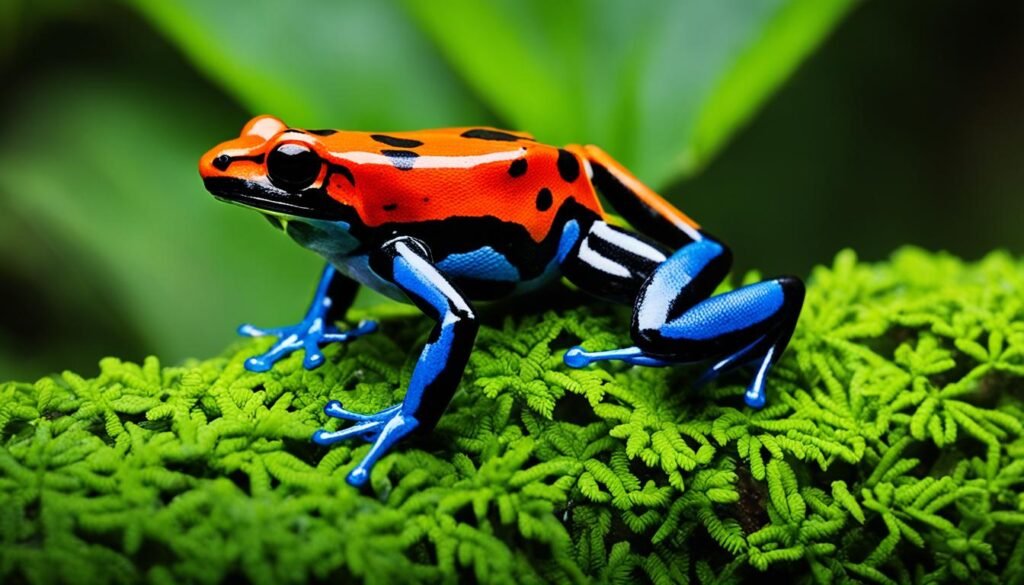
Poison dart frogs face threats from habitat loss and the illegal pet trade. Dynamic conservation efforts are crucial for their survival. In 1998, Ivan Lozano found nearly 800 of these colorful frogs at El Dorado International Airport in Bogotá, Colombia. Despite many deaths, the staff at a rescue center worked hard to save the endangered Lehmann’s poison frogs.
The illegal wildlife trade makes $10 to $20 billion a year. Frogs captured for exotic pets add to this. Lozano started Tesoros de Colombia to protect these frogs through captive breeding and sustainable commerce. They can now produce up to 1,500 frogs each year.
Tesoros de Colombia helps protect Colombian frogs from smuggling. They breed frogs responsibly, lowering the demand for wild-caught ones. For example, the price of a golden poison frog dropped from $100 to less than $35, making illegal trade less appealing.
- Tesoros de Colombia focuses on saving species that are at risk and often smuggled.
- They educate and promote regulation compliance among collectors.
- Lower prices for legally bred frogs help fight the illegal wildlife trade.
A 124-acre nature reserve now exists in Colombia for the endangered golden poison dart frog. Located in the Chocó forest, the reserve fights against illegal mining and water pollution, protecting the frogs and their habitat.
In captivity, these frogs become less toxic because they eat crickets and fruit flies instead of their usual diet. Changing their diet reduces their toxicity. Practices like these, along with local traditions of using frog toxins without harm, support frog conservation.
Groups like the World Land Trust and Global Wildlife Conservation fund the nature reserve. This effort is part of the Chocó Corridor project. It aims to save the poison dart frogs and other creatures living in these vital habitats.
What Makes Poison Dart Frogs Poisonous?
Poison dart frogs boast vibrant colors as a warning sign. They hold strong toxins that make them dangerous. Let’s look into why they’re toxic, their diet’s role, how different species vary in toxicity, and why they’re less toxic in captivity.
The Diet-Centric Toxin Theory
Scientists have long wondered why poison dart frogs are so toxic. Recent studies suggest their diet is key. Eating certain ants and beetles gives them their toxic power. This is because these insects have harmful chemicals, which the frogs use for their defense.
Toxicity Differences Among Poison Dart Frog Species
Diet and environment cause big differences in toxicity among species. The golden poison frog, Phyllobates terribilis, is one of the deadliest. It can kill ten adults with the toxin in its skin. This shows the range of their chemical defenses.
Why Captive Dart Frogs Are Less Toxic
Captive dart frogs aren’t as toxic as wild ones. This is due to their different diet in captivity. Feeding on crickets and fruit flies, they lose their toxic edge. This fact is vital for those who want to keep them as pets. It shows how their wild diet is linked to their toxic abilities.
| Statistic | Relevance to Toxicity | Impact on Conservation |
|---|---|---|
| 800 found in single shipment | High demand for toxic species | Increased illegal trade threat |
| ~95% fatality from toxin contact | Efficacy of poison | Highlight need for habitat protection |
| Toxicity loss in captivity | Dietary change impact | Support for captive breeding success |
| Ant-based diet toxicity source | Core of diet-centric toxin theory | Potential for controlled studies and education |
It’s important to understand how poison dart frogs’ diets and habitats affect their toxic traits. This knowledge helps with their preservation. By focusing on their needs and the dangers they face, we can support conservation efforts. Working together, we can ensure these colorful creatures survive for years to come.
Poison Dart Frogs in Captivity vs. the Wild
Poison dart frogs live differently in the wild compared to captivity. This difference highlights how their diet, our conservation efforts, and the pet trade affect their survival. The attraction to their bright colors and strong poisons has boosted the pet trade. Sadly, this harms their genetic diversity and chances of surviving.
Differences in Diet and Poison Levels
In the wild, poison dart frogs eat a variety of insects. This diet gives them their famous poison. They consume over 80 types of toxic substances found in their prey. In captivity, they eat different food, leading to lower poison levels. It shows how hard it is to copy their natural habitat and maintain their toxicity.
The Link Between Captivity and Conservation
Yet, captivity is vital for saving poison dart frogs. Groups like Tesoros de Colombia show that careful breeding can help wild populations. Even if captivity can’t match wild poison levels, it fights illegal trade. It also educates people about the importance of protecting these amphibians.
- Illegal wildlife trade revenue from poison dart frogs is estimated to range from $10 to $20 billion annually.
- Conservation-driven captive breeding like that at Tesoros de Colombia produces up to 1,500 frogs a year, counteracting the need for wild-caught specimens.
- The significant price drop for legally bred frogs to under $35 each illustrates the positive economic impact of captivity on reducing wild frog exploitation.
- Captive breeding is reshaping collector mindsets, fusing hobby with conservation, and aligning them with the protection of at-risk species.
Our work with poison dart frogs tells a story of survival. Captivity, combined with real conservation efforts, helps protect them from illegal trade. The goal is a future where wild and captive poison dart frogs thrive. With ongoing research and ethical care, this dream can become reality.
Educational Opportunities to Support Dart Frog Conservation
Amid the vibrant colors and powerful toxins, poison dart frogs capture hearts and minds. They are in danger, with over 30% of frog species facing extinction. This highlights the importance of education in saving these amphibians. Educational programs link people closely with these remarkable frogs, aiding their conservation.
Poison dart frogs have lived on Earth for nearly 300 million years. They are among the oldest creatures here. But since the 1950s, their numbers have gone down sharply. Education aims to stop this decline. Schools and zoos teach people why these frogs matter by showing their role in nature and health.
These frogs matter in science too. They make a painkiller much stronger than morphine. This shows how saving them could help medical science. Protecting these frogs is not just about nature. It’s also about keeping possible medical breakthroughs alive.
Educational opportunities increase awareness critically. Things like workshops and exhibits change how we see these frogs. They urge us to help, whether we’re in the jungle or the lab. Teaching people about these frogs helps us ensure they survive and thrive, not vanish.
- Interactive Exhibits: Zoos and museums teach the public about poison dart frogs in memorable ways.
- School Outreach Programs: Curricula bring the story of poison dart frogs to students, highlighting their role in nature and medicine.
- Conservation Workshops: Events that teach how to keep nature’s balance and biodiversity.
Our efforts with poison dart frogs are about more than facts. They’re about making people care and act to save these incredible frogs for the future.
Conclusion
In our journey to protect poison dart frogs, we’ve learned a lot. We’ve looked at their habitat issues and the creative ways to save them. We’ve also seen important research that highlights how special these frogs are.
One study in French Guiana shows us that poison dart frogs have personalities, even when they’re tadpoles. These personalities affect their chances of surviving and having babies. This was found in research that’s been shared in big science journals.
Scientists found that traits like being bold help frogs mate and keep their babies safe. This goes against the idea that all species survive in the same way. It shows us that different behaviors can be good or bad for the frogs.
We’ve come to see saving poison dart frogs as a big task. It needs both protecting their homes and understanding how they act. Knowing that traits like boldness stay with them from tadpole to adult is exciting. It gives us new ways to help them.
These discoveries inspire us to work harder to protect these colorful frogs. By learning, sharing, and acting, we can keep their world alive for future generations.
FAQ
Are poison dart frogs endangered?
Yes, many poison dart frog species are endangered. This is noted on the IUCN Red List due to threats they face.
What is the allure and danger of poison dart frogs?
Poison dart frogs are famous for their bright colors. These colors warn that they are very toxic. Touching these frogs is risky because of the powerful toxins in their skin.
Why are tropical rainforests significant for dart frogs?
Poison dart frogs thrive in tropical rainforests. They need the moist environment and leaf litter to survive.
How does deforestation impact poison dart frog populations?
Deforestation removes the natural homes of poison dart frogs. This leads to fewer places for them to live and a drop in their numbers.
What are the effects of climate change on poison dart frogs?
Climate change can upset the balance in rainforest ecosystems. This makes it hard for dart frogs to find what they need to live.
How do pollution and habitat destruction threaten dart frogs?
Pollutants from farms can harm the water and soil, hurting dart frogs. Destroying their homes, like through logging, also takes away their living spaces.
How does the illegal pet trade endanger poison dart frogs?
The illegal pet trade decreases poison dart frog numbers. People catch them to sell as exotic pets.
What are the main environmental threats to poison dart frog species?
The biggest dangers are logging, the spread of chytrid fungus, and agrochemical use. These threaten poison dart frogs and where they live.
What conservation efforts are being made to protect poison dart frogs?
Groups and people are focusing on restoring habitats and breeding frogs in captivity. They aim to save and protect poison dart frogs.
How do poison dart frogs obtain their toxicity?
Scientists are still figuring this out. But, it seems their diet, which includes certain insects, makes them toxic.
What are the differences between captive and wild poison dart frogs?
Frogs in captivity might eat differently and have less poison than wild frogs. Keeping them in captivity also helps conserve their species.
What educational opportunities support dart frog conservation?
Zoos, museums, and education programs help teach people about saving dart frogs. They spread awareness on why it’s important to conserve them.

